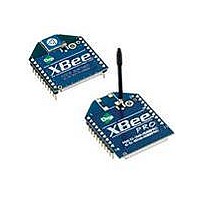XBP09-DPSIT-156 Digi International, XBP09-DPSIT-156 Datasheet - Page 24

XBP09-DPSIT-156
Manufacturer Part Number
XBP09-DPSIT-156
Description
MODULE XBEE PRO W/RPSMA
Manufacturer
Digi International
Series
XBEE-PRO™r
Specifications of XBP09-DPSIT-156
Frequency
902MHz ~ 928MHz
Data Rate - Maximum
156kbps
Modulation Or Protocol
FHSS
Applications
ISM
Power - Output
17dBm (50mW)
Sensitivity
-100dBm
Voltage - Supply
3 V ~ 3.6 V
Current - Receiving
80mA
Current - Transmitting
210mA
Data Interface
PCB, Through Hole
Antenna Connector
RP-SMA
Operating Temperature
-40°C ~ 85°C
Package / Case
Module
Lead Free Status / RoHS Status
Lead free / RoHS Compliant
Memory Size
-
Lead Free Status / Rohs Status
Lead free / RoHS Compliant
Other names
602-1169
4. XBee‐PRO® DigiMesh 900
DigiMesh Networking
DigiMesh Feature Set
Networking Concepts
Device Configuration
Network ID
Operating Channel
Mesh networking allows messages to be routed through several different nodes to a final
destination. DigiMesh firmware allows system integrators to bolster their networks with the self-
healing attributes of mesh networking. In the event that one RF connection between nodes is lost
(due to power-loss, environmental obstructions, etc.) critical data can still reach its destination
due to the mesh networking capabilities embedded inside the modules.
XBee-PRO 900 modules support a point-multipoint firmware variant and a DigiMesh firmware
variant. The following section applies only to the DigiMesh variant.
DigiMesh contains the following features
DigiMesh modules can be configured to act as routers or end devices with the CE command. By
default modules are configured as routers and will actively relay network unicast and broadcast
traffic as described below.
DigiMesh networks are defined with a unique network identifier. This identifier is set with the ID
command. For modules to communicate they must be configured with the same network identifier.
The ID parameter allows multiple DigiMesh networks to co-exist on the same physical channel.
XBee PRO-900 modules utilize frequency hopping spread spectrum technology. There are 8
defined hopping patterns which operate on 12 physical channels. (The International variant has 4
hopping patterns on 5 physical channels). The hopping pattern is selected using the HP command.
For modules to communicate, the hop sequence (HP) and network identifier (ID) must be equal on
all modules in the network.
© 2009 Digi International, Inc.
• Self-healing
• Peer-to-peer architecture
• Quiet Protocol
• Route Discovery
• Selective acknowledgements
• Reliable delivery
• Sleep Modes
Any node may enter or leave the network at any time without causing the network as a whole
to fail.
No hierarchy and no parent-child relationships are needed.
Routing overhead will be reduced by using a reactive protocol similar to AODV.
Rather than maintaining a network map, routes will be discovered and created only when
needed.
Only the destination node will reply to route requests.
Reliable delivery of data is accomplished by means of acknowledgements.
Low power sleep modes with synchronized wake are supported, with variable sleep and wake
times.
24














